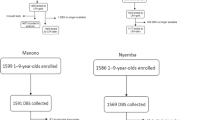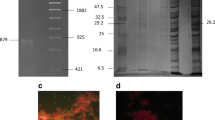Abstract
The applicability of a commercial direct immunofluorescent monoclonal antibody assay for detection of Chlamydia trachomatis elementary bodies was studied on endocervical smears from 506 women attending a venereal disease clinic. The aim of this prospective examination was to simulate a daily routine. The results were compared to those of a well-functioning tissue culture assay. The overall positivity was 22.7 %. Based on a positivity criterion of ⩾ 1 elementary body in the fluorescent antibody assay, the two assays agreed in 84.8 % of the cases. In 50 specimens the antibody assay was positive and the culture assay negative, whereas in 23 the culture assay was positive and the antibody assay negative. The positive predictive value was 63.8 %. Most of the discrepancies were found in specimens containing few elementary bodies or inclusions. Based on a criterion of ⩾ 10 elementary bodies, the positive predictive value was 70.9 %, but the sensitivity fell to 67.5 %.
Similar content being viewed by others
References
Centers of Disease Control:Chlamydia trachomatis infections. Morbidity and Mortality Weekly Report 1985, 34: S53-S74.
Thomas, B. J., Evans, R. T., Hutchinson, G. R., Taylor-Robinson, D.: Early detection of chlamydia inclusions combining the use of cycloheximide-treated McCoy cells and immunofluorescence staining. Journal of Clinical Microbiology 1977, 6: 285–292.
Munday, P. E., Johnson, A. P., Thomas, B. J., Taylor-Robinson, D.: A comparison of the sensitivity of immunofluorescence and Giemsa for stainingChlamydia trachomatis inclusions in cycloheximide-treated McCoy cells. Journal of Clinical Pathology 1980, 33: 177–179.
Stephens, R. S., Kuo, C.-C., Tam, M. R.: Sensitivity of immunofluorescence with monoclonal antibodies for detection ofChlamydia trachomatis inclusions in cell culture. Journal of Clinical Microbiology 1982, 16: 4–7.
Stamm, W. E., Tarn, M., Koester, M., Cles, L.: Detection ofChlamydia trachomatis inclusions in McCoy cell cultures with fluorescein-conjugated monoclonal antibodies. Journal of Clinical Microbiology 1983, 17: 666–668.
Zapata, M., Chernesky, M., Mahony, J.: Indirect immunofluorescence staining ofChlamydia trachomatis inclusions in microculture plates with monoclonal antibodies. Journal of Clinical Microbiology 1984, 19: 937–939.
Hallsworth, P. G., McDonald, P. J.: Detection ofChlamydia trachomatis with fluorescent monoclonal antibody. Pathology 1985, 17: 500–502.
Stephens, R. S., Tam, M. R., Kuo, C.-C., Nowinsky, R. C.: Monoclonal antibodies toChlamydia trachomatis: antibody specificities and antigen characterization. Journal of Immunology 1982, 128: 1083–1089.
Nowinski, T. C., Tam, M. R., Goldstein, L. C., Strong, L., Kuo, C. C., Corey, L., Stamm, W. E., Handsfield, H. H., Knapp, J. S., Holmes, K. K.: Monoclonal antibodies for diagnosis of infectious diseases in humans. Science 1983, 219: 637–644.
Wingerson, L.: Two new tests for chlamydia get quick results without culture. Journal of the American Medical Association 1983, 250: 2257–2259.
Harper, I., Shearman, M., Dalgety, F., Cole, D.: Fluoresceinconjugated monoclonal antibodies to detectChlamydia trachomatis in smears. Lancet 1985 ii: 509.
Krech, T., Gerhard-Fsadni, D., Hofmann, N., Miller, S. M.: Interference ofStaphylococcus aureus in the detection ofChlamydia trachomatis by monoclonal antibodies. Lancet 1985, i: 1161–1162.
Francis, R. A., Abbas, A. M. A.: Fluorescein-conjugated monoclonal antibodies to detectChlamydia trachomatis in smears. Lancet 1985, ii: 222.
Rettig, P. J.: Chlamydia and otitis media. Lancet 1985, ii: 558.
Parkinson, S. T.: Fluorescein-conjugated monoclonal antibodies to detectChlamydia trachomatis in smears. Lancet 1985, ii: 222–223.
Volkert, M., Matthiesen, M.: Ornithosis-related antigens fromBacteroides anitratum in the serological diagnosis of ornithosis. Acta Pathologica Microbiologica Scandinavica 1958, 44: 278–286.
Brade, H., Brunner, H.: Detection of chlamydia inclusion bodies with antisera toAcinetobacter calcoaceticus subspeciesanitratus by indirect immunufluorescence. Infection 1980, 8: 215–216.
Thornley, M. J., Zamze, S. E., Byrne, M. D., Lusher, M., Evans, R. T.: Properties of monoclonal antibodies to the genus-specific antigen of chlamydia and their use for antigen detection by reverse passive hemagglutination. Journal of General Microbiology 1985, 131: 7–15.
Tam, M. R., Stamm, M. E., Handsfield, H. H., Stephens, R., Kuo, C. C., Holmes, K. K., Ditzenberger, K., Krieger, M., Nowinski, R. C.: Culture-independent diagnosis ofChlamydia trachomatis using monoclonal antibodies. New England Journal of Medicine 1984, 310: 1146–1150.
Williams, T., Maniar, A. C., Brunham, R. C., Hammond, G. W.: Identification ofChlamydia trachomatis by direct immunofluorescence applied in specimens originating in remote areas. Journal of Clinical Microbiology 1985, 22: 1053–1054.
Colimon, R., Scieux, C., Roseto, A., GuiUemin, M. C., Perol, Y.: Détection d'antigénes chlamydiens dans les polynucleaires et macrophages des produits pathologiques á l'aide d'anticorps monoclonaux. Presse Médicale 1983, 12: 2334.
Berron, S., Vazquez, J., Fenoll, A.: Rapid detection ofChlamydia trachomatis. Lancet 1984, ii: 109–110.
Hawkins, D. A., Thomas, B. J., Taylor-Robionson, D.: Rapid detection ofChlamydia trachomatis with monoclonal antibodies. Lancet 1984, ii: 38.
Mallinson, H., Turner, G. C., Carey, P. B., Khan, M. M.: Rapid detection ofChlamydia trachomatis with monoclonal antibodies. Lancet 1984, i: 1180–1181.
Stamm, W. E., Harrison, H. R., Alexander, E. R., Cles, L. D., Spence, M. R., Quinn, T. C.: Diagnosis ofChlamydia trachomatis infections by direct immunofluorescence staining of genital secretions. Annals of Internal Medicine 1984, 101: 638–641.
Thomas, B. J., Evans, R. T., Hawkins, D. A., Taylor-Robinson, D.: Sensitivity of detectingChlamydia trachomatis elementary bodies in smears by use of a fluorescein-labelled monoclonal antibody: comparison with conventional chlamydia isolation. Journal of Clinical Pathology 1984, 37: 812–816.
Uyeda, C. T., Welbon, P., Ellison-Birang, N., Shunk, K., Tsaouse, B.: Rapid diagnosis of chlamydial infections with the MicroTrak Direct Test. Journal of Clinical Microbiology 1984, 20: 948–950.
Catalan, F.: Apport des méthodes récentes au diagnostic des Chlamydioses. Annales de Biologie Clinique 1985, 43: 157–161.
Alexander, I., Paul, I. D., Caul. E. O.: Evaluation of a genus reactive monoclonal antibody in rapid identification ofChlamydia trachomatis by direct immunofluorescence. Genitourinary Medicine 1985, 61: 252–254.
Dutilh, B., Bebear, C.:Chlamydia trachomatis: recherche par test direct et par culture dans 100 prélévements génitaux. Annales de Biologie Clinique 1985, 43: 275–278.
Foulkes, S. J., Deighton, R., Feeney, A. R. B., Bohanty, K. C., Freeman, C. W. J.: Comparison of direct immunofluorescence and cell culture for detectingChlamydia trachomatis. Genitourinary Medicine 1985, 61: 255–257.
Quinn.T. C., Warfield, P., Kappus, E., Barbacci, M., Spence, M.: Screening forChlamydia trachomatis infection in an inner-city population: a comparison of diagnostic methods. Journal of Infectious Diseases 1985, 152: 419–423.
Kiviat, N. B., Peterson, M., Kinney-Thomas, E., Tam, M., Stamm, W. E., Holmes, K. K.: Cytological manifestations of cervical and vaginal infections. II. Confirmation ofChlamydia trachomatis infection by direct immunofluorescence using monoclonal antibodies. Journal of the American Medical Association 1985, 253: 997–1000.
Graber, C. D., Quilliamson, O., Pike, J., Valicenti, J.: Detection ofChlamydia trachomatis infection in endocervical specimens using direct immunofluorescence. Obstetrics Gynecology 1985, 66: 727–730.
Author information
Authors and Affiliations
Rights and permissions
About this article
Cite this article
Larsen, J.H., Wulf, H.C. & Friis-Møller, A. Comparison of a fluorescent monoclonal antibody assay and a tissue culture assay for routine detection of infections caused byChlamydia trachomatis . Eur. J, Clin. Microbiol. 5, 554–558 (1986). https://doi.org/10.1007/BF02017704
Issue Date:
DOI: https://doi.org/10.1007/BF02017704




